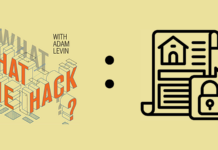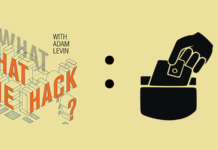
Nineteen a minute: That’s how quickly people become identity theft victims in the U.S. Estimates vary, but somewhere between 10 and 16 million Americans are defrauded each year in this way. Thanksgiving can be an awkward time of year for some victims, since family members account for more than 30% of the identity thieves.
Axton Betz-Hamilton knows this firsthand. Raised in a middle-class home—her mother Pamela was a tax preparer, her dad a department manager for a grocery store—her identity theft story is both a family affair and exponentially stranger than fiction.
“We lived on hobby farms—one in Portland, Ind., and then another in Redkey,” Betz-Hamilton told me. Thanksgivings were with family. Her paternal grandfather moved in during the ‘90s. (He had been a welder at a tractor factory.) Together, they were a small family unit that looked like many others, though in reality they were ensnared in a mindboggling circle of financial fraud.
“Nineteen Thanksgivings came and went, and [my mother] cooked those dinners for us—me and dad and my grandfather after he moved in in 1995. We were getting robbed by the hand that fed us the entire time,” she said.
The Damage
Betz-Hamilton’s identity theft story spans 20 years, starting in 1993. The charges on credit cards that were acquired using her Social Security number amounted to about $4,000, but the damage rippled out, impacting every aspect of her financial life.
Betz-Hamilton first discovered that she had been victimized when, as a 19-year-old college student, she was moving off-campus, and the utility company asked for a $100 deposit. The reason: bad credit. She ordered a copy of her credit report (while important for everyone, this is a crucial step for anyone who has been a victim of identity theft). She assumed there would be a one-pager featuring a couple student loans. Instead, a large manila envelope arrived. She then contacted the Identity Theft Resource Center, a nonprofit organization dedicated to helping victims of identity theft. They told her to file a police report. She did that, and waited as nothing happened.
When she disputed the accounts with one of the credit card companies, she was told that her story did not hold up. “There had been two payments before the account was maxed out.” This was earlier in the evolution of identity theft, so all the various tactics were still unknown, but it is not uncommon for an identity theft to try to extend the value of a target by making things appear to be as normal as possible.
“My credit report was 10 pages long, and my credit score was 380,” she said.
The consequences Betz-Hamilton faced will be familiar to anyone who has ever struggled with a bad credit history. “I had to pay higher interest rates for my car loan and the credit cards I legitimately obtained. My first car loan was 18.23% and my first credit card had a 29.9% APR. I’ve had to pay deposits for electric, phone and cable. I had to pay higher insurance rates through 2009.”
The lifetime cost of identity theft is staggering, since bad credit can impact so many pieces of your financial life, as Betz-Hamilton discovered. You can see how your credit scores stack up for free on Credit.com.
Anatomy of Family Fraud
In 1993, Betz-Hamilton’s parents were victims of identity theft. When she found out that her identity had been stolen, the most logical assumption was that whoever had stolen her parents’ identities had stolen hers as well. Another 18% of identity theft victims are defrauded by friends, neighbors and in-house employees. It took 20 years and a fluke discovery for her to learn the truth.
Pamela Betz died of cancer in 2013, and the details of her secret life emerged. She had stolen her daughter’s identity. She had stolen her husband’s identity. She compromised her father-in-law for around $1,500. And of course she herself had mountains of debt.
Betz-Hamilton’s father made the discovery after finding a blue plastic file-box in one of the outbuildings on their farm. Inside, there was a 12-year-old credit card statement. The account was in his daughter Axton’s name. It was overdue, and so he called his daughter to give her a hard time about this hidden bit of past ignominy. She told him the card never existed. Upon closer inspection, the account had a card in his wife’s name.
The 20-year fraud began to unravel.
“She had a lot of purses and backpacks, and that’s where she stored the paper trail,” Betz-Hamilton recalled. “It was also between dresser drawers. Papers were folded and shoved into books. We didn’t know my grandfather’s identity had been stolen until I found a credit card statement in one of those purses, and I still don’t know how far back that goes.”
Questions arose. Was there another house somewhere, cars or perhaps another life? On her deathbed, an alarm rose when Betz-Hamilton’s father noticed that his wife’s wedding ring was missing.
“We think she pawned it,” Betz-Hamilton told me. “I have no idea what she was up to. Maybe she had a second life. She had been using multiple names. I’m still looking.”
Dr. Axton Betz-Hamilton is now a professor at Eastern Illinois University where she teaches courses on personal finance and consumer issues. She wrote her Ph.D dissertation on child identity theft; how people experience it, looking specifically at victims under the age of 18 who learn about their situation later in life.
“My mother’s last wishes were to be cremated, and we respected that. She wanted her ashes to be with me. I’m sitting next to my mother right now,” she told me over the phone.
“Sometimes I yell at her. And sometimes I shake the box she’s in. We just don’t know who mom was. It’s hard to grieve for her. To change things up and start new traditions, I had Christmas at my house last year. Mom was here on the shelf. It was awkward.”
Indeed.










